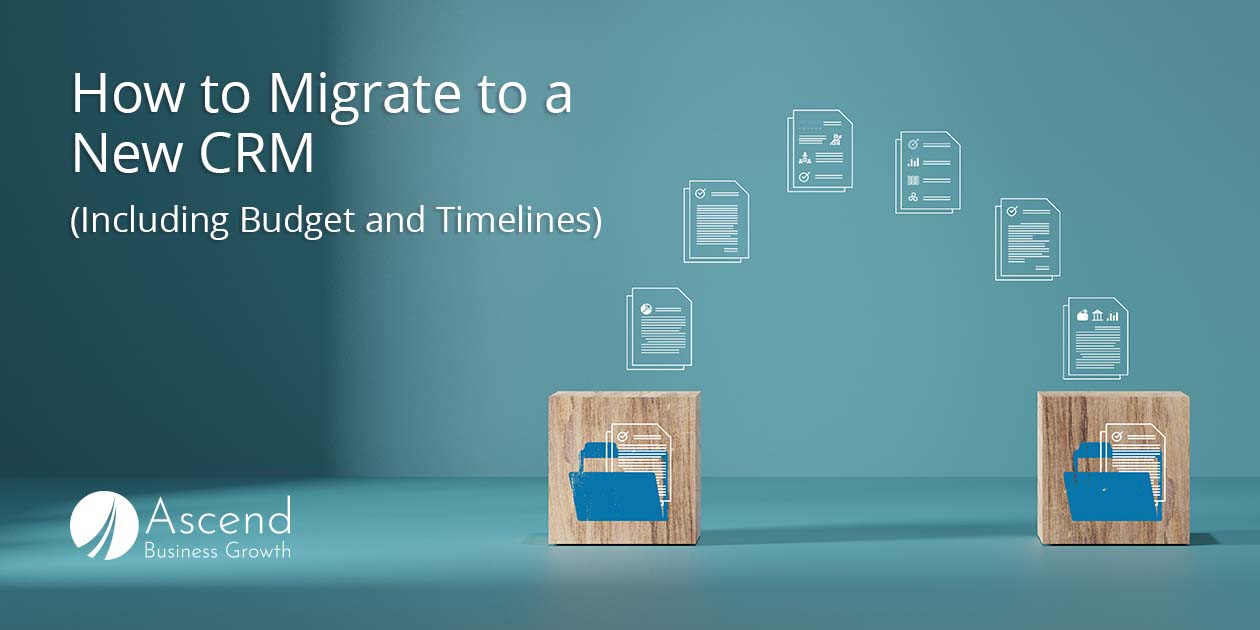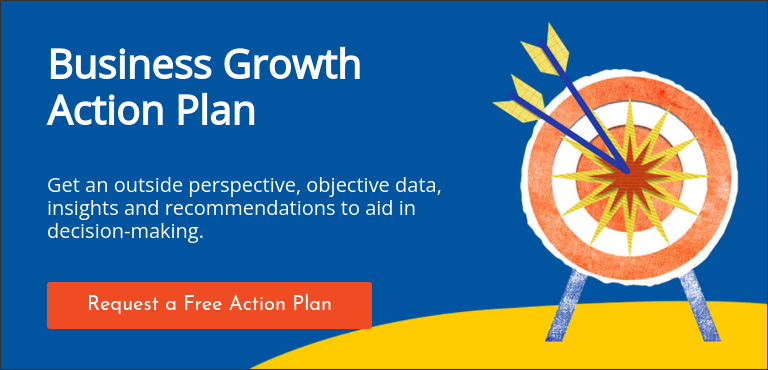
Migrating your CRM - or whatever system you currently use to manage your prospect and customer data - is daunting, but knowing what to expect and working with the right team can help make it a smooth transition. Here is an outline of how a CRM migration typically progresses, including budget and timelines.
Table of Contents
- Deciding to Make the Switch
- Review the Business Plan
- Map, Configure, and Import
- Initialize Critical Data Processes
- Training and Process Documentation
- Ongoing CRM Administration
- Budget and Timelines
Deciding to Make the Switch
Companies considering a CRM migration intimately understand the frustration and problems inefficient data processes can cause. Only so much company growth can happen when there is a lack of reporting capabilities, an inability to effectively track and follow up with prospects and customers, messy, unorganized data, and haphazard sales and marketing campaigns.
Before you embark on the data journey, the most important consideration is who will work on the project. Make sure the CRM team doing the work gets it, wants it, and has the capacity to do it.
Review the Business Plan
The migration project starts with a review of your business plan. Whether you work with an internal or external data and CRM specialist, everyone must be on the same page on the core business goals and objectives. Here are ten questions that drive the CRM configuration strategy.
- Why is it important to make a change now?
- What does success look like to you?
- What sales/marketing reports do you currently review or want to get?
- What is the process you currently use to store contact data? (other CRM, spreadsheets, multiple applications, etc.)
- Where does the data come from? (the data sources)
- How is the tracked and data managed? (what happens to the data once it's in the CRM)
- Who are your target audiences? (criteria or CRM Fields, such as job title, industry, # of employees, etc., that make up your ideal profitable customer)
- What information is essential for you to know about your prospects and customers?
- Who will use the CRM, and what are their roles?
- Who will administrate the CRM, and what are their roles?
The CRM contains the company's lifeblood: its customers and prospective customers. Without these people, there would be no company, so it's paramount to carefully consider how to store and report on their information.
Map, Configure, and Import
It all comes down to the "fields" or CRM properties. The new CRM system needs to align with the old data. Once the CRM is configured with the appropriate data points, the old data can be imported into the new system!
2 Snags to Be Aware Of
Mapping and importing seem simple enough, but two common snags slow the process.
1. Strategy Slowdowns: Many important business decisions are made during a CRM migration. Business leaders depend on the information housed there to drive strategy, budgets, resource allocation, revenue forecasting, and more. Getting a consensus can take time to ensure all stakeholders get what they need from the new system and agree to a new process.
2. Bad data: If the current data needs to be cleaned and organized, it needs to get cleaned and organized before it can be imported. Very often, data is not categorized correctly, so someone at the company who knows may have to sort through lists of contacts to verify if they are customers, target prospects, sales opportunities, etc., so they can be accurately reported in the new system.
You also want to avoid importing invalid contacts, so reviewing bounced emails, unsubscribed newsletter subscribers, or unqualified leads before a CRM migration will ensure optimal outcomes with the new system. Your CRM migration specialist will deliver these lists to you in small chunks to make reviewing the data as easy and fast as possible.
The Data Mapping Process
For most companies, the data mapping process goes something like this:
- List all the current data points.
- List all the "wish list" data points (this is where the conversation happens - what do you currently have that you don't need, and what don't you currently have that you do need).
- Match up the two lists and settle on the final list of data points.
- Configure the new CRM to accept all the current and wish list data points.
- Clean the current data so that it is accepted by the new CRM.
- Quality check.
Initialize Critical Data Processes
Data is fluid. Subscribers, prospects, and customers come and go, flowing from one buyer's journey stage to the next. Data maintenance processes are derived from a clear vision of what data to collect, what data to report on, and what follow-up actions the data should facilitate. They outline the critical requirements to keep track of the information as it shifts and changes.
Record Customizations
A CRM migration will only be successful if the data is easily accessible and usable. The various CRM objects (contacts, companies, deals) can be configured to show specific information related to CRM users' needs so they get quick access to the information they work with daily.
The bottom line is that not everyone needs to see and use the data in the same way, so to help everyone be successful, customize the records accordingly. And to help maintain data integrity, required fields can ensure the right data is collected and tracked.
Workflows
Automatic workflows are a great way to simplify data tracking and ensure data integrity. For example, if a company is your customer, a workflow can automatically mark all the contacts working there as a customer. Or, if a contact meets specific criteria like a form submission, a workflow can make them a lead and assign a task to a seller to follow up. Here are more examples of automatic data maintenance processes:
- Email Deliverability: workflows based on contact IP Country or Country data points that categorize contacts in accordance with data privacy laws from the EU (GDPR), California (CPPA), and Canada (CASL).
- Email Status: workflows based on the validity of the email address. For example, if an email soft bounces ten times, they are "blocked" and will not be qualified for an email subscription list. Or, if an email gets delivered and clicked, it is "valid," letting all CRM users know that the email address is good to go.
- Copy Property Workflows: Since Contacts, Companies, and Deals are separate "objects" within the CRM, sometimes you want data from one object copied to another. For example, if a company has a phone number and one of the associated contacts does not have one, the company number can be copied to the contact number.
- Set Property Workflows: Some data points can be automatically set, alleviating human intervention. Some examples include setting personas based on job titles, setting email subscriptions based on form submission, or setting a contact owner based on specific geographic data.
- Other Workflows: Your CRM migration team can set up other workflows, including automatic email drip campaigns, such as after a contact downloads an ebook, watches an on-demand webinar, or even after filling out a contact form. Or task-based workflows that give tasks to key stakeholders to follow up with prospects or customers at specific points in the buyer's journey.
Lists and Views
It's all about the people! Part of the CRM migration includes creating lists and views of the contacts and companies so sellers and marketers can do their thing. Some of the basics include:
- Email marketing lists
- Incoming lead views
- Engaged contact and company views
- Target account views
- Target prospect lists
Reports and Dashboards
At the end of the day, the reason for a CRM is to help business leaders get deeper insights into what's working and not working and make better data-driven decisions. All the data in the world is great, but it means nothing if you can't slice and dice it to answer important business questions like, "What are the hottest deals in the pipeline and their total projected value?"
The CRM migration process includes setting up dashboards to begin measuring progress and ROI on your sales and marketing campaigns. Examples of what types of analytics are on a dashboard include:
- Marketing: website traffic, organic leads, social analytics, email analytics, paid aid analytics
- Sales: Leads, meetings, opportunities, closed/won
- Clean up: highlight missing or wrong information for data maintenance, such as opportunities without contacts or contacts without first names.
Training and Process Documentation
Internal CRM users come and go as the company changes and develops. Ensuring everyone - new and seasoned - knows how your data policies and how your company uses the CRM is critical. Documenting and training core processes ensures consistency for the company over time and sets the framework for continuous improvement.
Before officially launching the new CRM, provide users with the training they need to work in the new system, whether through an in-person workshop, virtual live session, on-demand videos, or printed documentation.
Companies that don't have CRM training and process documentation risk having too many cooks in the kitchen, which wreaks havoc on data integrity, creating inaccurate dashboards and reports and poor business decisions. Don't skip the training and process documentation step!
Ongoing CRM Administration
Ongoing CRM administration ensures everything is up-to-date and accurate, CRM users are productive and satisfied with their work processes, and business leaders get the reports they need to drive business results. Some of the typical activities that happen during the CRM admin phase include:
- Ensuring all stakeholders have the info, lists, and reports they need
- Providing lead lists and engaged prospect lists to the sales team
- Oversight to ensure contacts are being followed up on promptly and the communication stream is effective
- Updating "bad" data
- Changes or adjustments to the CRM configuration as new users, processes, and approaches occur over time.
- Analyzing data to find quick wins and opportunities for growth
- Ongoing training and onboarding support
- Ensuring data policies are compliant with laws and regulations
A CRM is not a stagnant business asset. It is an essential business tool that needs ongoing and careful oversight to be effective.
The Budget & Timeline
CRM Migration
The job overview:
- Business Review
- Data mapping, configuration and import
- Data process initialization
- Record customization
- Workflows
- Lists and Views
- Reports and Dashboards
- Training and Process Documentation
The budget overview:
- The typical budget: $3,000 to $10,000
- The typical timeline: 30 to 60 days
Ongoing CRM Administration
The job overview:
- Data quality control and compliance
- CRM configuration updates
- Workflow quality control and updates
- Setting up lists and views
- Analytics, reports and dashboards
- Training, onboarding, and support
The budget overview:
- Once the initial migration is complete and everyone is up and running, the average budget for CRM admin is $500-$2500.
- Timeline: Monthly

Comments